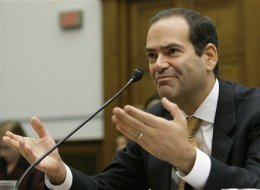TARP Watchdog Neil Barofsky: Government Bailout Has Increased Risk Of Economic Crisis
WASHINGTON — The government's response to the financial meltdown has made it more likely the United States will face a deeper crisis in the future, an independent watchdog at the Treasury Department warned.
The problems that led to the last crisis have not yet been addressed, and in some cases have grown worse, says Neil Barofsky, the special inspector general for the trouble asset relief program, or TARP. The quarterly report to Congress was released Sunday.
"Even if TARP saved our financial system from driving off a cliff back in 2008, absent meaningful reform, we are still driving on the same winding mountain road, but this time in a faster car," Barofsky wrote.
Since Congress passed $700 billion financial bailout, the remaining institutions considered "too big to fail" have grown larger and failed to restrain the lavish pay for their executives, Barofsky wrote. He said the banks still have an incentive to take on risk because they know the government will save them rather than bring down the financial system.
Barofsky also said his office is investigating 77 cases of possible criminal and civil fraud, including crimes of tax evasion, insider trading, mortgage lending and payment collection, false statements and public corruption.
One case concerns apparent self-dealing by one of the private fund managers Treasury picked to buy bad assets from banks at discounted prices. A portfolio manager at the firm apparently sold a bond out of a private fund, then repurchased it at a higher price for a government-backed fund. A rating agency had just downgraded the bond, so it likely was worth less, not more, when the government fund bought it. The company is not being named pending the outcome of Barofsky's investigation.
Barofsky renewed a call for Treasury to enact clearer walls so that such apparent conflicts are less likely.
Treasury said it welcomed Barofsky's oversight but resisted the call to erect new barriers against conflicts of interest. The new rules "would be detrimental to the program," Treasury spokeswoman Meg Reilly said in a statement. The existing compliance rules "are a rigorous and effective method of protecting taxpayers," she said.

Much of Barofsky's report focused on the government's growing role in the housing market, which he said has increased the risk of another housing bubble.
Over the past year, the federal government has spent hundreds of billions propping up the housing market. About 90 percent of home loans are backed by government controlled entities, mainly Fannie Mae, Freddie Mac and the Federal Housing Administration.
The Federal Reserve is spending $1.25 trillion to hold down mortgage rates, and millions of homeowners have refinanced at lower rates.
"The government has stepped in where the private players have gone away," Barofsky said in an interview. "If we take government resources and replace that market without addressing the serious (underlying) concerns, there really is a risk of" artificially pushing up home prices in the coming years.
The report warned that these supports mean the government "has done more than simply support the mortgage market, in many ways it has become the mortgage market, with the taxpayer shouldering the risk that had once been borne by the private investor."
Barofsky's report echoed concerns raised by housing experts in recent months, as home sales and prices rebounded. They warn that the primary reason for the turnaround last year has been billions of dollars in federal spending to lower mortgage rates and prop up demand.
Once that spigot of cash is turned off, they caution, the market will be vulnerable to a dramatic turn for the worse. Daniel Alpert, managing partner of investment bank Westwood Capital, wrote in a report that national home prices are bound to fall 8 to 10 percent below the lows of last spring.
"The lion's share of the remaining decline will occur in markets that saw sizable bubbles but have not yet retrenched," he wrote.
Officials from the Obama administration counter that massive federal intervention has helped the housing market stabilize and prevented more dire consequences.
Barofsky's report also disclosed that, while the Obama administration has pledged to spend $75 billion to prevent foreclosures, only a tiny fraction – just over $15 million – has been spent so far. Under the Making Home Affordable program, only about 66,500 borrowers, or 7 percent of those who signed up, had completed the process as of December.
He said the key to preventing future crises is to reform Fannie Mae and Freddie Mac, create and improve loan underwriting and supervision of banks. He stopped short of endorsing specific proposals for overhauling financial regulation, but said many of the proposals would go far to improving the system.







DANIEL WAGNER AND ALAN ZIBEL | 01/30/10 11:59 PM |